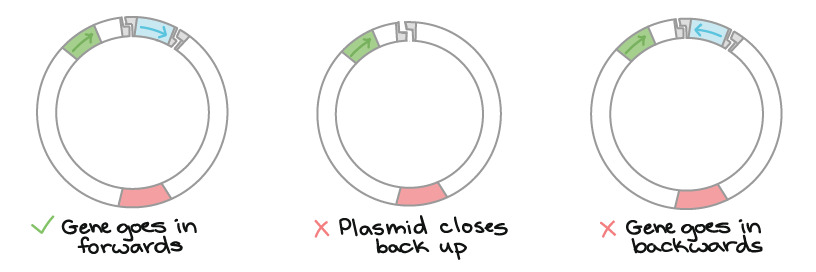Recombinant DNA
Enzymes:
enzymes are protein-based molecules that facilitate various biochemical reactions, including the cutting and joining of DNA strands
enzymes have an active site, which is where they bind with other molecules to combine or decompose them.
what are restriction enzymes?
enzymes that cut double-stranded DNA at a unique, specific place
two types of restriction enzymes:
endonuclease - makes cuts within the DNA molecule
three types - type II is used in rDNA technology as it makes cuts within recognition sites
examples: Eco R1, Hind III
exonuclease - removes nucleotides from the ends of the DNA strand
why the name restriction enzyme?
the enzymes of bacterium restrict the replication of viral genome
how do restriction enzymes cut DNA molecules?
recognition sites - DNA sequence of base pairs that reads the same on two strands in the 5’-3’ & 3’-5’
What is Recombinant DNA
DNA fragments that are extracted from an organism and then inserted into another organism to change the genome and phenotype.
How Does Recombinant DNA Work?
isolation - DNA is extracted from the source organism, and specific genes are targeted.
cutting DNA - restriction enzymes cut the DNA at specific sequences, creating fragments with blunt and sticky ends.
insertion - the DNA fragment is inserted into a vector, such as a plasmid or virus, which serves as a carrier for the DNA.
ligation - DNA ligase (‘lig-’ means ‘tie’) seals the DNA fragments into the vector, creating recombinant DNA.
transformation - the recombinant DNA is introduced into a host organism, such as a bacterium, using heat shock or electroporation techniques.
replication and expression - the recombinant DNA replicates and expresses the desired trait inside the host.
What is the Point of Recombinant DNA?
to manipulate what millions of years of evolution have allowed us to do
allows us to change genomes for all reasons
improve our immune systems to make us healthier
give organisms desired traits
medicine
production of insulin and vaccines efficiently and at a low cost
agriculture
development of genetically modified organisms
improved yield, pest resistance, and/or nutritional value.
research
replication of organisms to study viruses, diseases, and genetics
industry
manufacturing enzymes for detergents and biofuels.
Bacterial Transformations
Why Transform Bactiera?
genetic engineering
the old - the domestication of plants and animals through farming and selective breeding
the new - the direct alteration of an organism’s genetics to achieve desirable traits through the process of genetic engineering
genetic engineering involves the use of recombinant DNA technology
the recombinant DNA is then introduced into a host organism
The Tools of rDNA
plasmids - vectors used to transfer DNA
double-stranded DNA that replicates independently of the bacterial chromosome
can be genetically engineered
selectable marker
help researchers separate bacteria carrying the plasmid from bacteria not carrying the plasmid
most commonly antibiotic-resistant
recognition sites
ori region
